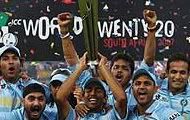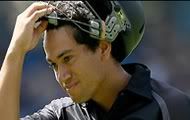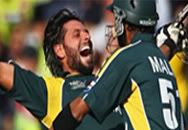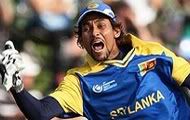
Sri Lanka had ended Day 3 by reaching an ominous position and they spent half of Day 4 strengthening that position, until they reached a total that they could be sure had batted India out of the match. While it couldn't have been fun for the Indian team to toil away while the Lankan batsmen helped themselves to tons of runs, the Lankans batted for a tad too long and showed a defensive and conservative mindset, when they ought to have been aggressive while trying to notch their first Test win on Indian soil.
However, picking too much on the Lankans for batting a tad longer than necessary would be churlish. They put on a magnificent batting display right from the start through till the end of the innings. The Jayawardene combo continued to torment the Indians for much of the time, being unseparated till lunch time. During the first session, Prasanna Jayawardene reached his second Test century and first against India, while Mahela Jayawardene went past 250, as the partnership crossed the 300-run mark. Both batsmen looked like they had never left the pitch yesterday, taking no time at all to settle in and play their shots. The bowlers, unfortunately for India, looked to be in the same state, and they couldn't make an impression on the duo. After a while, the Indians were just going through the motions, and waiting for Sri Lanka to declare.
Being reduced to waiting for the opponents to declare is one of the most powerless, and worst, feelings a player can have - no matter if you're playing gully cricket, school cricket or international cricket. For Rahul Dravid and Sachin Tendulkar - the only two surviving members from the team of 1997 that conceded a world record 952/6 declared to Sri Lanka - it must have brought back unpleasant memories. Finally after lunch, the Indians - who must have forgotten the feeling of taking a wicket - got one, when Mahela Jaywardene was bowled by the otherwise unimpressive Amit Mishra. Jaywardene had made 275 runs - nearly each one coming of silken strokes. By the time he was out the score-board read an imposing 726/6. With the lead at 300 runs, the Lankans could very well have declared right then, but they chose to bat on. Eventually Dammika Prasad was dismissed with the score at 760, and that is when Sangakkara decided that they had enough on the board to send the Indian batsmen in.
Prasanna Jayawardene had remained unbeaten on 154 and during his partnership with Mahela Jayawardene, they had both set some records. The most famous one they set was when they broke a 72-year old world record for the sixth wicket partnership, bettering none other than the great Sir Donald Bradman and Jack Fingleton. (For a full list of the records they broke, click here.)
The Sri Lankans thus had a 334-run lead, and had left themselves four and a half sessions in which to either bowl the Indians out for less than that or bowl them out early enough so that Sri Lanka could chase down whatever target India set. When India came out to bat, it very nearly looked like they would lose by an innings. Sehwag started off in his usual style, blazing away. But he failed to curb his instincts in the face of such a large deficit and was lucky to survive when two he was dropped twice of edges and was saved from being run-out by miles when the throw missed the stumps. Although one of the drops was off a no-ball, it should have served as a warning to Sehwag, but he blithely ignored it even if it did.
India survived the session without losing a wicket, as Gambhir - looking very solid at one end - and Sehwag settled down after the initial rush. However, disaster struck at the start of the last session of the day, when Sehwag - still displaying a maddening inability to control his rushes of blood, played an ugly slog to a flighted Herath delivery only to see it take the top-edge and spiral safely into the hands of Angelo Mathews. It was a dismissal that Sehwag would not like to see on any replay ever in his life, and it put India in a needless spot of bother. The openers had added 81 runs, and looked set for more, when Sehwag had his rush of blood.However, solidity returned to the proceedings with the arrival of Rahul Dravid. Dravid too looked like he was merely continuing his first innings, and looked in good nick from the time he took guard.
Slowly but surely, Dravid and Gambhir chipped away at the deficit, maintaining a healthy scoring rate without taking any risk. They both displayed great concentration and looked intent on carrying India through to safety at least till the end of the day. Gambhir reached a well deserved half-century, and Dravid looked set to join him before an umpiring error ended his stay. Dravid played across the line to a ball from Welegedera that was bowled round the wicket and angling in, and was rapped on the pads only for umpire Harper to uphold the appeal. To the naked eye, the ball looked like it was clearly sliding down the leg side, and Hawkeye suggested that it would have had the faintest possible contact with the leg stump. Dravid was disappointed and justifiably so, because on a batting beauty and in good form, he had looked immovable till then. India then sent out Amit Mishra as the night watchman, and he kept Gambhir company till the close of play. India ended at 190/2, still 144 runs adrift, but with Gambhir looking assured on 74.
With the pitch not holding any demons, what India have to do is guard against the sort of collapse that happened on the first day of the match, because on the fifth day such a collapse would prove fatal, especially with Rahul Dravid not around to bail them out this time. If the batsmen keep their cool, it should be easy for India to draw the match, but there are two things they must guard against - any rushes of blood and the possibility of Muralitharan weaving magic on a last day pitch.


















Shout about this post:
0 comments to “India fighting for survival”
Post a Comment